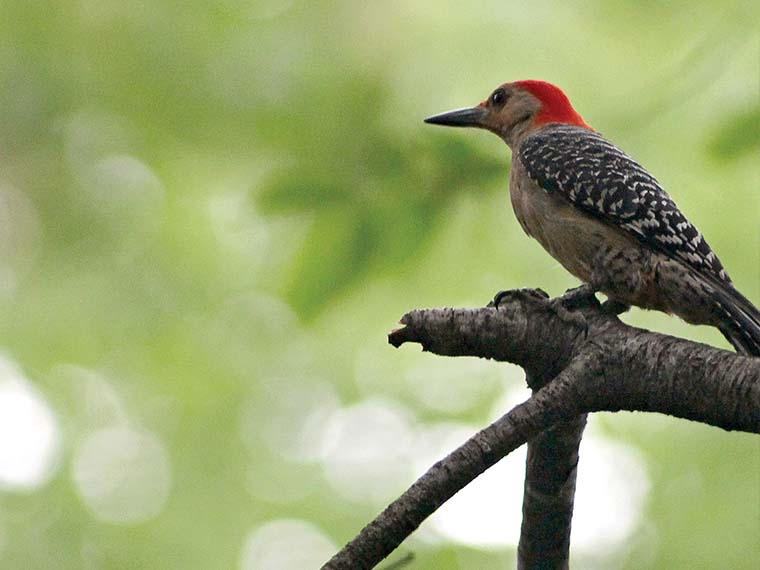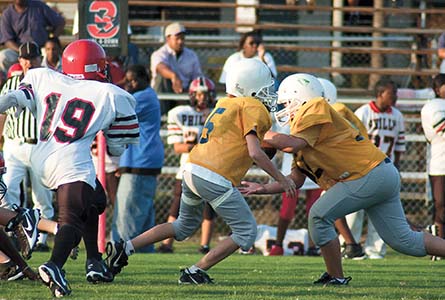The information presented on this page may be dated. It may refer to situations which have changed or people who are no longer affiliated with the university. It is archived as part of Mississippi State University's history.
While Mississippi State University is bulldog country, one university research team might soon have us all rooting for woodpeckers, too.
While it is hard to imagine the woodpecker as a fierce competitor on the football field, there is a correlation between the bird's superior shock absorbing capabilities and the game on the gridiron.
Nayeon Lee, biological engineering doctoral student at MSU, described the red-bellied woodpecker's shock absorbing capabilities in the May 8 edition of the Journal of the Royal Society Interface. Lakiesha Williams, associate professor of agricultural and biological engineering in the university's Mississippi Agricultural and Forestry Experiment Station and Mark Horstemeyer, CAVS chair professor in mechanical engineering, directed Lee's research.
Lee reported that a woodpecker's beak repeatedly strikes a tree trunk at the speed of 14 -16 miles per hour. This speed is similar to how fast professional football players run on the field and is the speed considered in standard requirements for designing football helmets.
However, the shock a woodpecker absorbs from the impact is much greater than anything a football player will likely experience.
"For humans, only 9 g's (nine times that of gravity force) can cause a head injury, and typical traumatic brain injury occurs between a deceleration of 80 and 100 g-forces while the woodpecker decelerates around 1,000 g-forces," Williams said. "Insight into the woodpecker's ability to sustain this kind of stress may lead to the design of man-made materials that provide better protection for players on the field and others involved in collision forces."
A woodpecker's beak is made up of three structural layers: an outer layer comprised of a protein called keratin, a middle foam layer, and an inner bony layer. There is a gradient with each material blending into the next.
"The scales on the outer layer fit together in an overlapping pattern, are much denser than the scales found in other bird beaks and operate as a shearing mechanism to dissipate shock," Lee said. "Specifically, the wavy gap between the scales, similar to a suture line, is three times wavier compared to other bird beaks, like a chicken or Toucan, and this geometry dissipates shock energy by dispersing impact waves."
The porous middle layer acts as the glue and aids in shock absorption by binding the neighboring two very structurally-diverse layers. The inner layer, which is less porous than the inner layer found in other bird beaks, provides strength to the beak and guides the shock wave through the head, Lee added.
"This research illustrated that the components of the woodpecker's beak make up a well-defined system, but all three materials play individual roles in the dissipation of shock energy," Williams said.
Results from this research contributed to a recently patented idea. Horstemeyer was successful in patenting specific shock mitigating materials and methods found in nature for use in man-made design principles.
The study has inspired new research projects for Lee, Williams, and Horstemeyer. Lee will now focus on computational modeling of the woodpecker's entire head, which basically puts the woodpecker in a virtual environment to evaluate how shock propagates. Lee will also continue to focus on the beak's middle layer to determine if there is specific shock mitigation occurring in that particular layer as well. As this research continues, Lee, Williams, and Horstemeyer see promise in applying biological principles to man-made design in football helmets and beyond. The study also addresses an Experiment Station research priority to prevent disease, injury and disability, subsequently enhancing the quality of life for Mississippi residents.
"Our hope is that we are able to establish design principles inspired by nature that will help us develop light-weight, energy mitigating materials that provide better protection on point of impact," said Williams.


